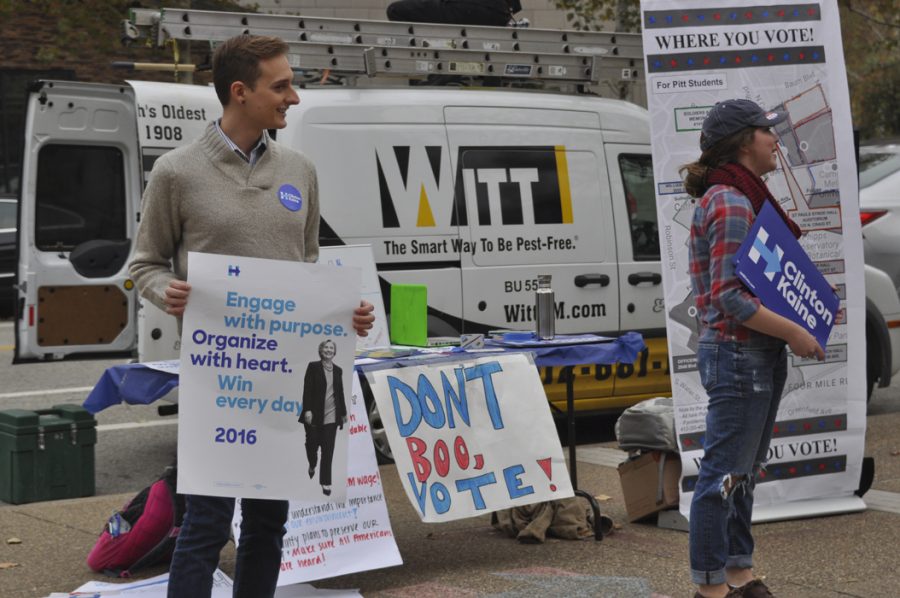The final months of 2016’s election season on Pitt’s campus were rather blue — and by blue, I mean pro-Clinton.
As I made my way through campus, I’d see students sporting the Clinton campaign logo on stickers and buttons. I’d try my best to avoid eye contact with the tables of canvassers asking if I’m registered to vote and, if I was, encouraging me to vote for the candidate who supported their particular cause. If I had to guess, these people weren’t pushing me to vote Jill Stein.
The visibility of Trump supporters on Pitt’s campus was limited — mainly represented by a table set up outside the library just before Election Day — and it seemed like Clinton’s popularity here was overarching. Because of this, along with reputable polls predicting her win as likely as a white actor’s Oscar nomination, Clinton supporters, including myself, felt perhaps a little too comfortable. Come election night, Trump’s win shook all of us.
As I reflect on the election, I should’ve had better foresight into what could, and did, happen on Nov. 8. Myself and other Pittsburgh Clinton supporters made a mistake: not campaigning harder in areas that were less of a guaranteed win for Clinton. We should have broken out of Oakland’s blue bubble.
Sometime before the election, I had received a call from the Luzerne County Democratic Party asking for who I was voting for. When I said I was voting for Clinton, the woman on the phone sounded astonished. Her over-enthusiastic response to my answer indicated that perhaps she hadn’t been having much luck prior to my phone call.
When I visited home in October, I was almost jaded by the amount of Trump signs, whereas when I saw a Trump sign in Oakland, I felt angry and empowered to stress why I felt Clinton was the better candidate. I was almost always ready to converse with someone about the election, as long as it was at Pitt — a place where I knew I had people to back me up.
Looking back, I should have been more active at home in Luzerne. I had many friends and family members who I could have spoke with and shared my insight. What was the worst that can happen? A disagreement? The best that could have happened was someone understanding my points and passing it on. My silence helped nobody.
Since moving into my first-year dorm, the time I’ve spent outside of campus, including my home in Avoca, Pennsylvania, has been brief. I’ve been able to forget about life outside of my largely insular college world. The same seemed to be true of the Clinton campaign itself, and Democrats going forward must avoid its mistake of ignoring the state’s red and purple areas.
In Allegheny County, Hillary Clinton won by almost 17 percent. This might not come as too much of a shock, given how popular Clinton was among voters age 18-34. Had the American voting population consisted entirely of this young demographic, the former Secretary of State would have won 42 states — as well as the District of Columbia — according to SurveyMonkey, a company that provides polling for companies including NBC and Facebook.
In Bradford County, which isn’t packed with college campuses like Allegheny is, Trump’s win was substantial. Given its more rural location, older population and historical conservatism, a Trump win in Bradford was just as predictable as a Clinton win in Allegheny.
Campaigning for Clinton in Allegheny was just as redundant as campaigning for Trump in Bradford.
There were other counties where the possible outcomes were far more gray — and that’s where we should have gone to stump for her. In Northampton County, Trump won by just under 4 percent, or only 5,464 votes. In 2012, Northampton, along with 10 other flipped counties, voted Democratic.
Northampton could have been significant in Clinton winning Pennsylvania. Northampton County, according to the 2015 Census, includes about 247,268 eligible voters, but practically half of that eligible population didn’t make it out to the polls.
But in 2016, Clinton made no stops in Northampton. Her presence — or a larger presence of her campaigners — in counties like Northampton, which include metropolitan areas such as Easton and Bethlehem, could have influenced people who were undecided as well as those who didn’t end up voting at all.
Across the country, rural voters fueled Trump’s win. Trump won about 62 percent of this demographic, which normally votes conservative but came out in significantly higher numbers this election. People in these areas have felt “left behind” by the economy and current government, which likely caused them to vote for Trump.
But they also felt left behind by Clinton’s campaign.
Right before the election, Trump made an effort to rally in rural counties, which was likely why he won by a much higher margin in these areas than his GOP predecessor, Mitt Romney, did in the 2012 election.
Clinton’s almost complete lack of attention to those voters while she was touring the east coast probably didn’t do much to convince them their voices had a place in her hypothetical White House.
Given Clinton’s slim loss in this state, any vote could have made a difference.
But to put all of the blame on Clinton and her campaigners would be naive. Being from Luzerne County, an area that did vote conservative, I should have focused my efforts as a Clinton supporter toward that area, especially given my own knowledge of the lack of support she had there.
As Democrats at Pitt, perhaps we can make more of a difference if we try to address the people who aren’t already on our side.
Write to Julia Aldrich at jla85@pitt.edu



